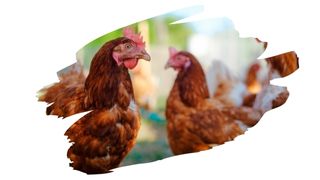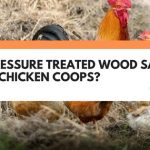A chicken coop made out of the right type of durable material can last for years. But, can the same be said for a chicken coop made from a manufactured wood such as OSB?
Well, in this post, we explain why OSB is not the best material to use for outdoor structures in general.
You will also learn what chemicals really go into the manufacture of OSB. And keep reading to find out what this can mean when it comes to the health of your chickens.

This post may contain affiliate links to products that we receive a commission for (at no additional cost to you). Learn more here.
Is OSB A Good Material For Outdoor Structures Such As A Chicken Coop?
No it isn’t. But, mainly because it is not suited for use in areas with a lot of moisture or humidity — such as the great outdoors. And this is because of the texture of OSB.
This manufactured wood is made by compressing flat wood chips together. And all of those chips are then held together using an adhesive.
Now, while OSB isn’t super water-absorbent like MDF, moisture can still soak (albeit fairly slowly) into this material all the same. And once there, it can take a very long time for OSB to dry out afterwards.
This is one of the reasons why OSB can tend to rot easily if it gets wet. Which is why using your standard OSB for an outdoor structure — such as a chicken coop — is a bad idea.
Having said that, there are some very expensive OSB grades that are designed to be much more water-resistant.
For example, OSB/4 sheets can handle very humid conditions, making them suitable for certain construction work such as siding. But even so, even the most water-resistant OSB material still won’t last long if it is left in direct ground contact.
In short, if enough moisture and humidity gets into OSB, it’ll soon succumb to rot.
Related Post: Can OSB Board Really Get Wet? (7 Things You Need To Know)
And How Long Does It Take OSB To Rot?
If that OSB doesn’t manage to dry out — like say for example, it’s in constant contact with moist ground soil — it will rot within a few months.
In fact, even OSB used on the interior of a coop, can succumb to rot. Especially as the inside of chicken coops can become very humid during hatching.
But, let’s say for the sake of argument, that OSB managed to somehow remain unaffected by all of the moisture outside. If that were the case, there’s still another problem in using OSB for a chicken coop.
And that problem comes down to the way this material has been made…
Related Post: Is There A Safe Non-Toxic Wood Sealer For Chicken Coops?
And What Is OSB Made Of Exactly?
Well, just like Plywood and MDF, OSB is a manufactured wood. It may contain natural wood chips, but this material is wholly engineered.
OSB (Oriented Strand Board) is a composite material made from lots of thin strands of wood and chemical glues. And when it comes to chicken coops, this is an issue for two good reasons.
- OSB Provides The Ideal Place For Mites To Hide In
Those OSB strands can provide plenty of cracks and crevices for mites to live in.
And mites, such as Northern Fowl mites and Red Roost mites, will happily make their home in those OSB walls. And those mites can cause incredible discomfort for chickens.
- OSB Is Made Using Formaldehyde Resins
Those OSB wood strands are all held together using a lot of glue. But, the glue used to make this material contains formaldehyde resins; either Melamine-Urea-Formaldehyde (MUF) or Phenol Formaldehyde (PF).
Needless to say, formaldehyde is infamous for being a very dangerous substance. Whether it is ingested, or inhaled, it can have a severe effect on the health of your chickens.
Formaldehyde, however, is at it’s most dangerous in vapor form. So, off-gassing formaldehyde glues can be very toxic.
Off-gassing simply refers to the fumes that come off of solvents, glues, and paints as they dry. And while it can take these substances a few hours to dry to the touch, they can continue to off-gas for months afterwards.
And formaldehyde based glues are no exception. Phenol Formaldehyde glues in particular can continue to off-gas and release fumes for up to 24 months.
Newly manufactured OSB will do most of it’s off-gassing whilst it’s at the mill (or in the store). Nevertheless, this is another point of concern when it comes to the health of your chickens.
Related Post: Is There A Chicken-Safe Paint? (All About VOC-Free Chicken Coop Paint)
So, Should I Skip Over Using OSB For A Chicken Coop?
You should not use OSB for a chicken coop. It is not suitable for exterior conditions. And only very expensive types of OSB, such as OSB/4, will be able to handle the humidity inside a coop.
On top of that, OSB carries with it possible chicken-health risks from the glues used to make this material. And that is not to mention the increased difficulty of keeping this material free of mites.
To Wrap Up, Here Are The 3 Key Takeaways From This Post…
- 1). OSB is a manufactured wood made from thin wood strands. Those strands are then held together using formaldehyde-based glues.
- 2). The texture of OSB provides plenty of crevices for mites to hide, making it harder to get rid of them.
- 3). OSB is not a suitable material for exterior structures, such as a chicken coop. Also, standard OSB will rot due to the humidity inside a coop as well.
References:
Simple and accurate temperature correction for moisture pin calibrations in oriented strand board (fs.fed.us)
Phenol Formaldehyde | ScienceDirect.com

